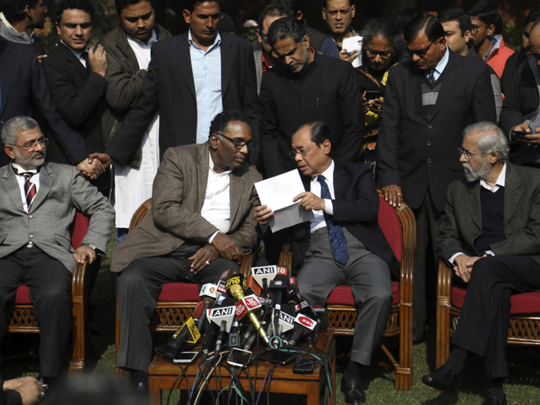
Democracy is in danger”, these very words shook India last week. The words were not being pronounced by pessimistic journalists like us or leaders of the opposition drawing a tirade against the ruling dispensation, but by the four senior-most judges of the Supreme Court of India (SC).
The press conference was really a first in the history of independent India, best defined as a massive quake hitting the system, where sitting judges had to address the media, describing it as “people’s court”. At the meet, Justice J. Chelameswar, Ranjan Gogoi, Madan B. Lokur and Kurian Joseph expressed their disapproval in regard to their grievances over the internal functioning of the highest court of the land as they could not find a solution among themselves.
While “unprecedented” has become the de facto word being used in every Indian media in relation to the press conference, it is best described as the second largest shock to the pillars of Indian democracy post independence. The first jolt came on June 25, 1975, when Indira Gandhi’s government imposed the national emergency in fear of losing power and lifted it 21 months later, on March 21, 1977, when she realised that her party men were against it.
The Justices are unhappy with the way Chief Justice of India (CJI) Dipak Misra has been allocating cases of ‘national importance’ whose judgements can have far-reaching implications which can even alter the course of the nation to judges with less seniority. In the Supreme Court of India, seniority rules everything. From his or her stature in the system to appointments as chief justice and even being a member of the collegium which decides on persons nominated for elevation as judges to the high courts, its choices of candidates for elevation to the Supreme Court, and its decisions on transfer of judges between different high courts.
Since independence the main objective of the apex court is to defend the fundamental rights of the citizens enshrined in the constitution and uphold it in letter and spirit. The people at the centre of the issue — the four ‘dissenters’ or ‘rebels’ as they are being addressed by certain sections of the media known for their leanings either in favour of against the ruling party — are not only attacking the CJI for his subversion of powers but are bringing to the fore the supposed interference of the ruling party in the independence of the judiciary and its ensuing enslavement.
Abusing his executive powers
Though the judges refrained from pronouncing it, the principal disagreement between the four judges is that their disapproval is based in their perception that Justice Misra is abusing his executive powers to allot cases “selectively”, ignoring age old principles on allocation of judicial work. They have added for good measure that some of the cases have far-reaching consequences for the nation and the institution are being assigned to junior judges and Benches “of their preferences”, a suggestion that is being read by some as a portentous suggestion to a known and unknown external hand.
While it is not clear in how many cases such exceptions were made, the four judges seem to have had an issue over the petition that sought an inquiry into the death of special CBI judge B.H. Loya in 2014 being posted before a particular Bench. The deceased judge was hearing the Sohrabuddin ‘fake encounter’ case, in which Bharatiya Janata Party (BJP) president Amit Shah was an accused but later discharged. Given the political sensitivity of the matter, the concern expressed over this case is something that must be squarely addressed in a way that dispels any misgivings.
Of late, India has become a country practicing brut majoritarianism strangling free thought and stifling dissent in an institutional manner. Words such as ‘cow’, ‘Gujarat’, ‘Hindu India’, ‘Hindutva view of India’, ‘Aadhar’ have been added to his dictionary of “holy cows”, and anyone opposing it is being branded as “anti-national”.
A whole army of trolls has been unleashed on social media to abuse, threaten and shout down any voice of dissent and they are not even sparing Minister for External Affairs Sushma Swaraj who was abused for issuing visas to Pakistanis for treatment in India, forcing her to block many such handles. Borrowing a quote from the newly appointed Congress party president Rahul Gandhi, “Shut up India” — has become an official policy of the government in power.
Today, 43 years since the emergency, Indians take democracy for granted. But the outcry of the four judges shows that it is far from being safe. The reverberations of what took place on Friday will not easily subside and will be felt for a long time to come. It is probably imperilled once more as it has never been before and almost no one seems to be aware of it.
Update: On January 22, the Supreme Court of India transferred all petitions pending in the Bombay High Court demanding independent probe in the Judge Loya case to itself. They will now be heard along with two Public Interest Litigations (PILs) pending in the apex court on the same issue. A three-judge bench of Chief Justice of India Dipak Misra and Justices A. M. Khanwilkar and D.Y. Chandrachud also restrained all high courts from entertaining any petitions on the matter as the apex court was seized of it.
Archisman Dinda is a freelance journalist based in Kolkata, India.









